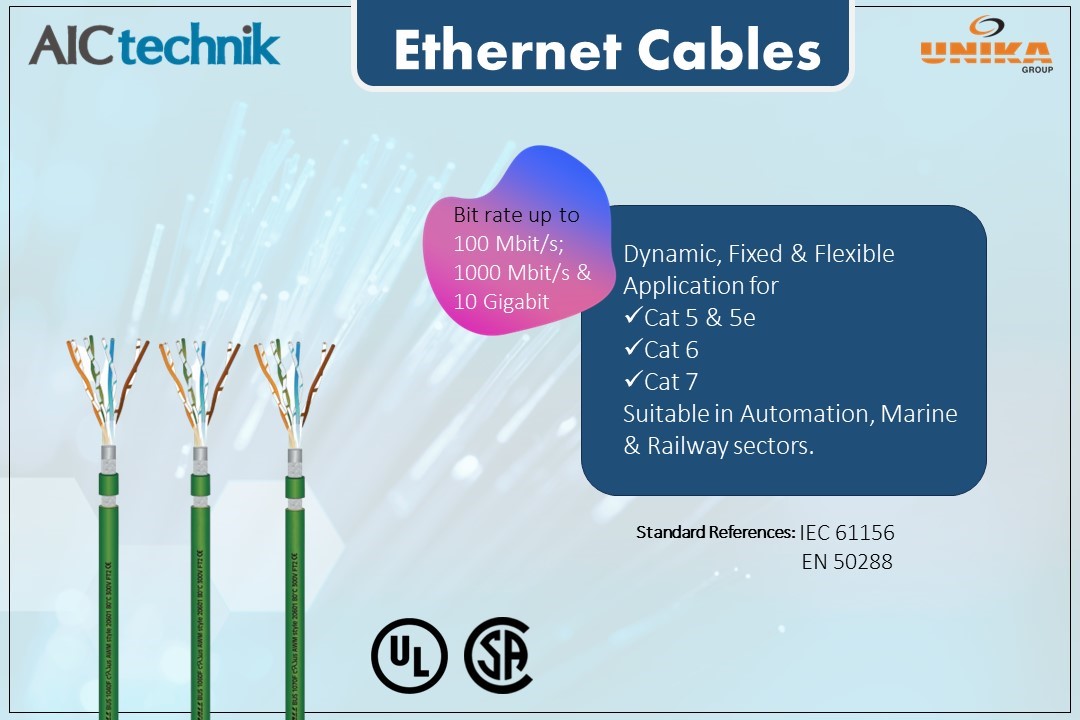
Something you need to know about Ethernet Cables specially for Automation
AIC Technik Pvt Ltd | 15 Jul, 2023When you talk about simple network, there is no major need to put ethernet cables under any analysis, however in a complex business network environment, a reliable underlying system of network cables is necessary for ensuring a healthy and efficient network. By understanding of the different ethernet cables, connectors, lengths and data rates can go a long way in helping you design an efficient computer network.
Well, everyone aware of ethernet cables as a network cables, those are cords that connect network components such as routers, modems, switches, computers, etc. This cable is carrying the network nodes, giving them access to the local area network (LAN) and the internet.
Ethernet cables plays a crucial role specially in business environments, where Wi-Fi technology is widely used. Hardwiring your network ensures that it is fast and consistent. Devices connected with ethernet cables don’t have to worry about sudden drops in network performance due to obstructions of Wi-Fi signal interference.
If you have been involved in any network installation, you might have heard of CAT5, 6 or 7 cables. The “CAT” in network cables is short for Category. This categories divide the cables into classifications based on bandwidth, data rates, and shielding.
Here overviews of the categories of the ethernet cables.
CAT 5/5e
Cat 5 cables are a grade of twisted-pair cables used primarily for computer networking. Their data rate up to 100 Mbps and were used to transmit data, video, and telephone signals. The CAT 5e can carry speeds of up to 1 Gbps and is more resistant to crosstalk. CAT5e cables are widely used and are recommended for sub-Gigabit networks. Our Ethernet Cables refer to American standard EIA/TIA 568B (Cat 5e) and European standard EN 50288 series suitable to meet the FAST ETHERNET requirements.
CAT 6
Cat 6 is another standardized twisted pair cable that meets more rigid specifications compared to Cat 5/5e. It includes a physical separator between its four pairs as well as foil shielding. Therefore, it can provide greater bandwidth and data rates of up to 1000 Mbps. This ethernet cables Cat6 SF/UTP (250MHz) refer to EN50288-5-2/1 series.
CAT 7
Cat 7 cables are similar in characteristics to Cat 6a but with greater shielding and use protective connectors. Its gives data rates of up to 10 Gbps. Our Ethernet Cables Cat 7 S/FTP (tested up to 750 MHz) refer to EN 50288 series.
The length of the Ethernet cable is an important factor to consider in networking even the loss of signal strength in networking cables. This means that the more the length over which a signal is transmitted, the more it disintegrates and distorts. Reduction can also be caused by external factors such as electrical currents and that is why cables have shielding with the aim to minimize such external influences. The longest length of ethernet cables over which they provide their maximum data rate is 100 m. Further than this length, the signal quality transmitted starts to degrade, making the network speeds and connection less reliable. In contrary, in many cases, higher data rates can be achieved over shorter distances.
The use of twisted pairs offers a solution to the issue of electromagnetic interference (EMI) that is caused by nearby electrical cables or appliances. Twisted-pair ethernet cables are sufficient to ensure high quality data transfer despite small levels of interference in most home and small business environments. But, in complex environments simple twisted pair ethernet cables suffer from interference caused by high powered equipment, elevators, large fluorescent lighting installation, etc. that blast right through unshielded ethernet cables. This results in a main effect on data transfer and speed.
Ethernet cables with shielding comes in following types.
STP- Shielded Twisted Pair
FTP- Foiled Twisted Pair
F/UTP- Outer Foil Shield/ Unshielded Twisted Pair
S/UTP- Outer Braided Shield/ Unshielded Twisted Pair
S/FTP- Outer Braided Shield/Foiled Twisted Pair
In Ethernet Cables, speed refers to the rate of which it can transmitted data. For instance, a speed of 100 Mbps means that the cable is capable of transmitting 100 Million bits of data per second. The speed of a cable can be identified from its category.
Here quick review of data rate and its bandwidth.
Category | Max. Data Rate | Bandwidth |
Cat 5e | 1 Gbps | 100 MHz |
Cat 6 | 1 Gbps | 250 MHz |
Cat 6a | 10 Gbps | 500 MHz |
Cat 7 | 10 Gbps | 600 MHz |
Cat 7a | 10 Gbps | 1000 MHz |
Ethernet cables are usually terminated using an RJ45 connector, where the RJ stands for Registered Jack, which known as standardized physical network connection or interface, where 45 stands to the number of the interface in the standard specification.
Ethernet cables that come with connectors at both ends are called patch cables. Patch cables are normally shorter than standard ethernet cables. We use snagless connector as it has a boot designs that protects the connector’s lock from being accidentally snapped off. It finds use in situation where the connector is frequently connected and disconnected.
Shielded cables in Ethernet cables with an outer jackets made from PVC class 43 according to UL1581, as well as it comes with Aluminium/polyester tape with tinned copper wire braid in overall shielding.
Ethernet cables having some features such as flame retardant, halogen gas emissions, Industrial oil resistance and water resistance according their certifications.
